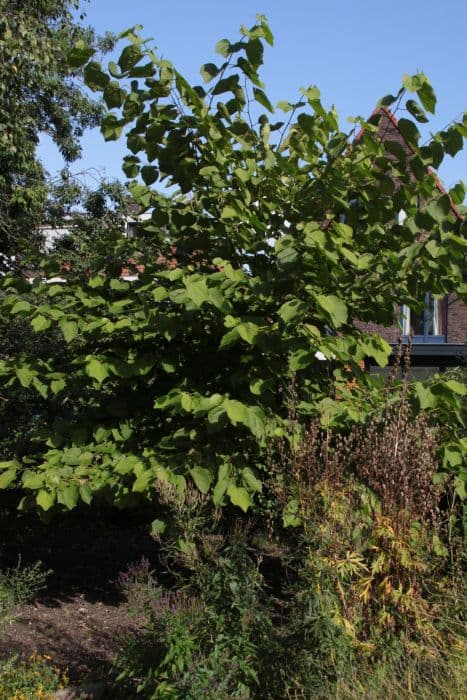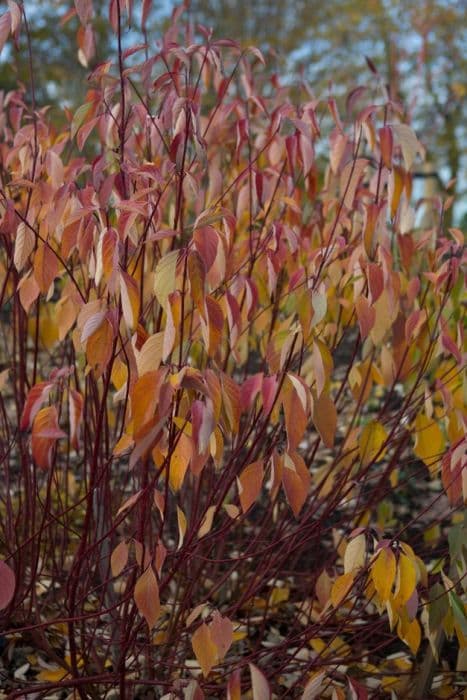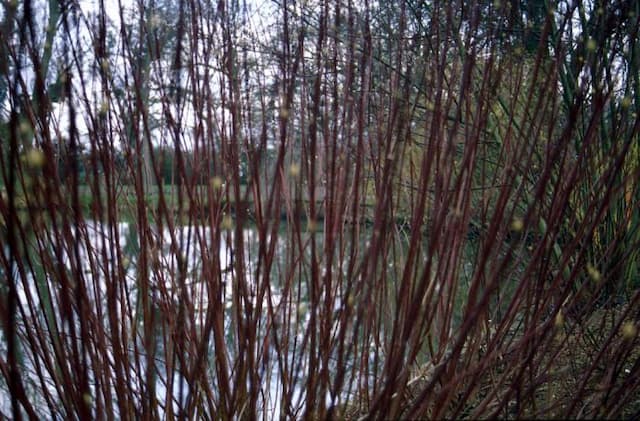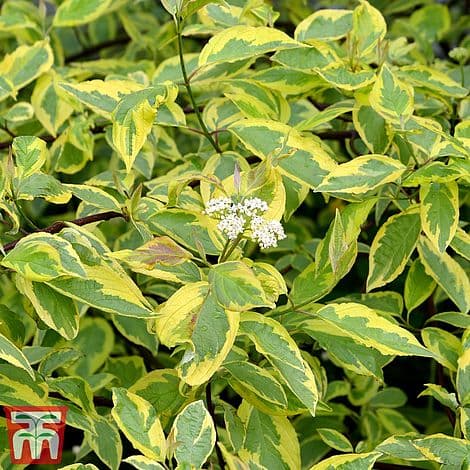Chinese dogwood Cornus kousa var. chinensis 'China Girl'











ABOUT
The plant known as 'China Girl' is a variant of Kousa Dogwood known for its exceptional ornamental qualities. This plant displays an abundance of large, star-shaped white flowers that bloom profusely in the late spring to early summer. These flowers are actually bracts, which are modified leaves that surround small, inconspicuous yellow-green flowers at the center. Following the flowering period, the plant produces round, berry-like fruits that are around an inch in diameter. These fruits start off green and gradually turn to a pinkish-red hue as they mature. The fruit is attractive to birds and other wildlife, adding to the plant's interest in a garden setting. The foliage of 'China Girl' is also attractive, with dark green leaves that are pointed at the end and have a somewhat wavy margin. The leaves turn to vibrant shades of red and purple, providing a striking display of fall color before they drop off for the winter. In terms of its structure, this Kousa Dogwood variant typically grows with a vase-like habit when young, becoming more rounded with age. The branching structure gives it a pleasing shape even in the absence of leaves. The bark is an attractive feature as well, with mottled patterns of gray and brown that provide texture and visual interest, especially in the winter months. Overall, 'China Girl' is celebrated for its multiseasonal interest, from the distinctive spring flowers and summer fruits to the colorful autumn foliage and attractive winter bark. It is a plant that adds beauty to the landscape throughout the year.
About this plant
 Names
NamesSynonyms
Chinese Dogwood, Chinese Kousa Dogwood, China Girl Dogwood.
Common names
Cornus kousa var. chinensis 'China Girl'.
 Toxicity
ToxicityTo humans
Kousa dogwood is generally considered safe for humans, and there are no widely recognized toxic effects associated with its consumption. In fact, the fruit of the Kousa dogwood is edible and is sometimes made into wine or jelly. While it is non-toxic, it's always possible for individuals to have specific allergies or sensitivities, so if someone experiences any adverse reactions after consuming any part of the plant, they should seek medical attention.
To pets
Kousa dogwood is not known to be toxic to pets. Dogs, cats, and other animals can sometimes experience mild stomach upset if they consume parts of the plant, such as leaves or stems, mainly due to the plant matter rather than specific toxins. However, the fruit of the Kousa dogwood is considered non-toxic and may be safely ingested by pets. As with humans, individual pets could have allergies or sensitivities, so if a pet shows signs of discomfort or illness after consuming any part of the plant, it's advisable to consult a veterinarian.
 Characteristics
CharacteristicsLife cycle
Perennials
Foliage type
Deciduous
Color of leaves
Green
Flower color
White
Height
15 - 20 feet (4.6 - 6 meters)
Spread
15 - 20 feet (4.6 - 6 meters)
Plant type
Tree
Hardiness zones
5
Native area
China
Benefits
 General Benefits
General Benefits- Ornamental Appeal: The plant offers a stunning display of star-shaped flowers in late spring, which can enhance the visual aesthetics of gardens and landscapes.
- Seasonal Interest: It offers multi-season interest with its bright red fruit and autumn foliage, which adds to the beauty of the garden throughout different seasons.
- Drought Tolerance: Once established, it has a good degree of drought tolerance, making it suitable for regions with water scarcity or for gardeners seeking water-wise plants.
- Pest Resistance: Generally resistant to many pests, ensuring lower maintenance and less need for chemical treatments.
- Disease Resistance: Exhibits resistance to common diseases that affect other species of Cornus, leading to a healthier and more robust plant.
- Wildlife Attraction: The fruit is attractive to birds, providing a valuable food source and encouraging biodiversity in the garden.
- Adaptability: Adaptable to a variety of soil conditions, which makes it versatile for planting in different garden situations and easier for gardeners to succeed with.
- Cold Hardy: It is capable of withstanding cold temperatures, making it appropriate for gardens in cooler climates.
 Medical Properties
Medical Properties- Antioxidant activity: The fruit of Cornus kousa has been found to contain high levels of antioxidants, which can help protect the body from oxidative stress and may contribute to reducing the risk of chronic diseases.
- Anti-inflammatory effects: Some studies have suggested that extracts from Cornus kousa may have anti-inflammatory properties, which could be beneficial in reducing inflammation associated with various conditions.
- Anticancer potential: Preliminary research has indicated that certain compounds in Cornus kousa might have anticancer effects, although this area requires further scientific investigation.
- Cardiovascular health: There is some evidence to suggest that the plant's extracts may offer protective benefits for heart health, such as improving blood lipid profiles, but this is still an emerging field of study.
- Antidiabetic activity: Early research has also hinted that Cornus kousa might help improve insulin resistance and other factors related to diabetes management.
 Air-purifying Qualities
Air-purifying QualitiesThis plant is not specifically known for air purifying qualities.
 Other Uses
Other Uses- Edible Fruit: The ripened fruit of Cornus kousa 'China Girl', often referred to as kousa dogwood, can be consumed fresh or used in recipes for jams, jellies, and desserts.
- Wildlife Habitat: This plant provides shelter and nesting opportunities for birds and other small wildlife in the garden.
- Dye Production: The bark and leaves can be used to produce natural dyes for textiles and crafts.
- Woodworking: The hard wood of the kousa dogwood is sometimes used for making small specialty items like tool handles and crafts.
- Cultural Significance: It's often planted in commemorative gardens or as a symbol in Eastern cultures due to its beauty and significance in various traditions.
- Erosion Control: The root system can help stabilize soil on slopes, preventing erosion.
- Photography: Because of its stunning flowers and picturesque appearance, the kousa dogwood is a popular subject for garden and nature photographers.
- Seasonal Decoration: The branches and fruits are used in floral arrangements and decorations, especially in fall and winter.
- Urban Planting: It's suitable for urban environments because it is tolerant of pollution and confined soil spaces.
- Ink Production: The berries, when crushed, can be mixed with other substances to create a natural ink for art purposes.
Interesting Facts
 Feng Shui
Feng ShuiThe Kousa dogwood is not used in Feng Shui practice.
 Zodiac Sign Compitability
Zodiac Sign CompitabilityThe Kousa dogwood is not used in astrology practice.
 Plant Symbolism
Plant Symbolism- Resilience and Durablity: As a sturdy and robust plant, the Kousa Dogwood symbolizes one's ability to withstand various challenges and adversities in life.
- Purity and Innocence: The white flowers of the Kousa Dogwood are often associated with purity and innocence, much like the symbolism attached to many white flowering plants.
- Renewal and Hope: Blooming in the late spring to early summer, the Kousa Dogwood represents renewal, a fresh start, and hope for the future.
- Beauty and Elegance: With its graceful form and beautiful flowers, this plant is often linked to beauty and elegance, celebrating natural aesthetics and poise.
- Christian Faith: In Christian symbolism, the Dogwood is often connected to faith and the crucifixion of Christ, where legend suggests the tree was used for the cross, and its flower shape holds a representation of the crucifixion scene.
 Water
WaterThe Chinese Dogwood should be watered deeply and thoroughly, so that the water penetrates several inches into the soil, ensuring the roots have adequate moisture. During its growing season in spring and summer, water the plant once a week with about 1 to 1.5 gallons of water, or more during hot, dry spells. In fall and winter, reduce watering to every two to three weeks depending on the weather. It's crucial to avoid overwatering and ensure good drainage to prevent root rot. Young trees will require more frequent watering while they establish their root systems.
 Light
LightThe Chinese Dogwood thrives best in locations that offer full sun to partial shade. An ideal spot would provide morning sunlight with some afternoon shade, or dappled sunlight throughout the day, especially in hotter climates. Avoid exposure to intense, direct afternoon sun to prevent leaf scorch.
 Temperature
TemperatureThe Chinese Dogwood prefers a temperature range between 60°F and 77°F for ideal growth. It can withstand minimum winter temperatures down to around -20°F, and is hardy in USDA zones 5 through 8. Protecting the plant from extreme temperatures by providing mulch can help ensure its survival and health.
 Pruning
PruningPrune the Chinese Dogwood to maintain shape and encourage new growth mainly during the dormant season in late winter or early spring before new leaves appear. Remove any dead, damaged, or crossing branches to promote good air circulation and prevent disease. Pruning every two to three years is usually sufficient for this species.
 Cleaning
CleaningAs needed
 Soil
SoilThe Chinese Dogwood 'China Girl' thrives in well-drained soil with a mix of two parts loam, one part sand or perlite, and one part organic matter such as peat or compost. The soil pH should be between 5.5 to 6.5 for optimal growth.
 Repotting
RepottingChinese Dogwood 'China Girl' should be repotted every 2 to 3 years when grown in containers to refresh the soil and accommodate root growth.
 Humidity & Misting
Humidity & MistingChinese Dogwood 'China Girl' prefers average to high humidity; however, it is adaptable and tolerates a range of conditions.
 Suitable locations
Suitable locationsIndoor
Ensure bright, indirect light and regular watering.
Outdoor
Plant in partial shade, mulch, and protect in winter.
Hardiness zone
5-8 USDA
 Life cycle
Life cycleCornus kousa var. chinensis 'China Girl', commonly known as Chinese dogwood 'China Girl', starts its life as a seed which, under favorable conditions, germinates in the soil. After germination, the seedling emerges and begins to develop its root system and first true leaves, gradually establishing itself as a young plant or sapling. As the sapling grows, it enters a vegetative stage, where it focuses energy on producing a strong stem, branches, and a broader leaf canopy. Following the vegetative stage, the plant reaches maturity and begins its reproductive phase, characterized by the production of showy, white to pink flower bracts in late spring to early summer, followed by the development of berry-like fruits that provide food for wildlife and can serve as a mechanism for seed dispersal. After flowering and fruiting, the Chinese dogwood 'China Girl' enters a period of maintenance, where growth slows, and it invests energy into strengthening and perpetuating itself year after year. The lifecycle completes when the plant eventually ages and dies, though it can live for several decades under optimal conditions.
 Propogation
PropogationPropogation time
Spring to Early Summer
The most popular method for propagating the Chinese dogwood 'China Girl' is through softwood cuttings. This technique is usually undertaken during the late spring or early summer when the new growth is still flexible but has begun to mature. To propagate, gardeners cut a piece of the stem about 4 to 6 inches long, making sure that it includes at least two sets of leaves. The bottom set of leaves is removed and the cut end may be dipped into a rooting hormone to encourage root development. The cutting is then placed in a well-draining soil mix and kept moist and warm, ideally with bottom heat. A plastic bag or a transparent cover can be used to maintain humidity around the cutting. Roots typically develop within a few weeks to a couple of months, after which the new Chinese dogwood can be transplanted to a more permanent location.









